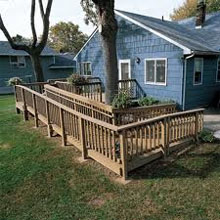
Access Ramps Resources
- Home
- Types of Access Ramps
- Access Ramps for Disabled
- Access Ramps for Sale
- Access Ramps for Wheelchairs
- Ada Access Ramps
- Building Access Ramps
- Disability Access Ramps
- Disabled Access Ramps
- Disabled Access Ramps Regulations
- Easy Access Ramps
- EZ Access Ramps
- FAQs Access Ramps
- Handicap Access Ramps
- Handicapped Access Ramps
- Lightweight Access Ramps
- Modular Access Ramps
- Portable Access Ramps
- Portable Disability Access Ramps
- Vehicle Access Ramps
- Wheelchair Access Ramps
Building Access Ramps
Access ramps are not just a quick way of accessing a building; they are a lifeline to independence for those who are disabled or relying on wheelchairs. They allow a sense of dignity that would otherwise be missing. They also take away frustration and give a higher quality of life to those who are disabled. Practicalities in life is something we all take for granted and consideration to wheelchair users and other people with disabilities has been brought to the fore with the enactment of the Americans With Disability Act since 1990. Access ramps are not only useful for people with walking difficulties; they can also help to make moving heavy wheeled objects easier. Since the passing of the ADA in 1990, all public buildings must provide access ramps and new buildings usually incorporate building access ramps into the architectural design of a building. Access ramps are not just required to gain access to a building per se, they can also help with accessing grounds or floors with different levels.
Choosing access ramp materials
Not only public buildings benefit from access ramps, many smaller building and dwellings can benefit from them too. Building access ramps as a permanent measure to help wheelchairs is usually made from concrete and cement building materials. Handrails can be made from aluminum or steel construction. Building access ramps that are not going to remain in place on a permanent basis can be made from wood or aluminum. There is also an array of completely portable ones too. They will still have to conform with the regulations and law to provide adequate safety as well as access.
Is building access ramps a straightforward affair?
Not just anyone can build access ramps onto their home. When considering building access ramps to enhance access to a private dwelling, the local authority must be consulted on the planning and it must be approved prior to work being carried out. If you fail to do this then no matter how sturdy and well built the access ramp is, they may ask for it to be taken down. Always ensure building permission has been obtained before considering building access ramps. This will save time and money for your access ramp building project.
Measuring up
It may sound obvious to measure up but if the measurements are incorrect, the whole ramp may not work properly and the wheelchair bound may have more difficulties trying to access the house. Not only can it be practically impossible to use but it can be dangerous too if built with the wrong materials with the wrong incline or gradient. There are regulations to the gradient and length when building access ramps so check these first and ensure the land leading up to the house will readily accept the access ramp at the correct level. Many a times, a private dwelling will not have enough land area to accommodate a straight ramp and in those cases, it may be necessary to consider a switchback ramp. This is a ramp that is straight and then angled. This will clearly add to the budget so it is important to get the measurements right when considering building access ramps around the home.
